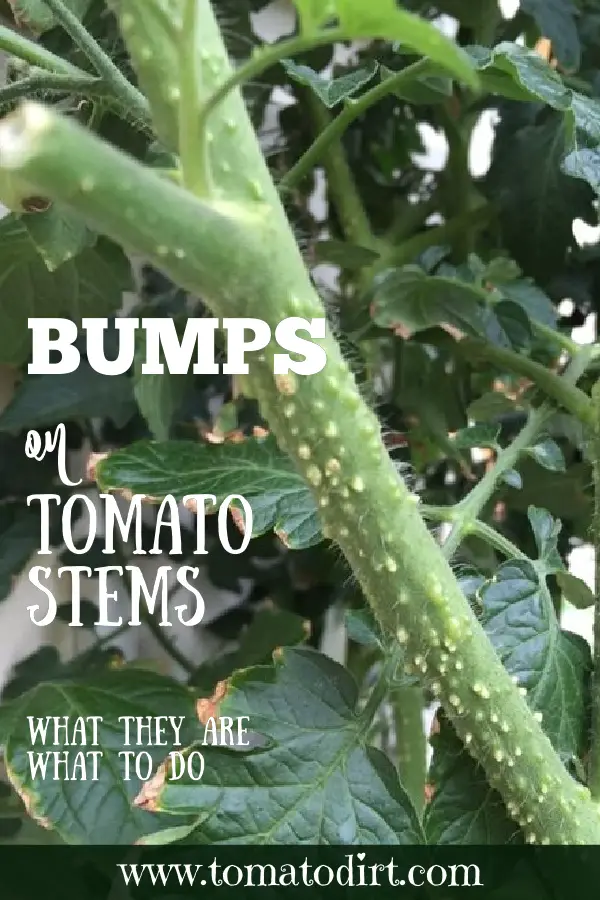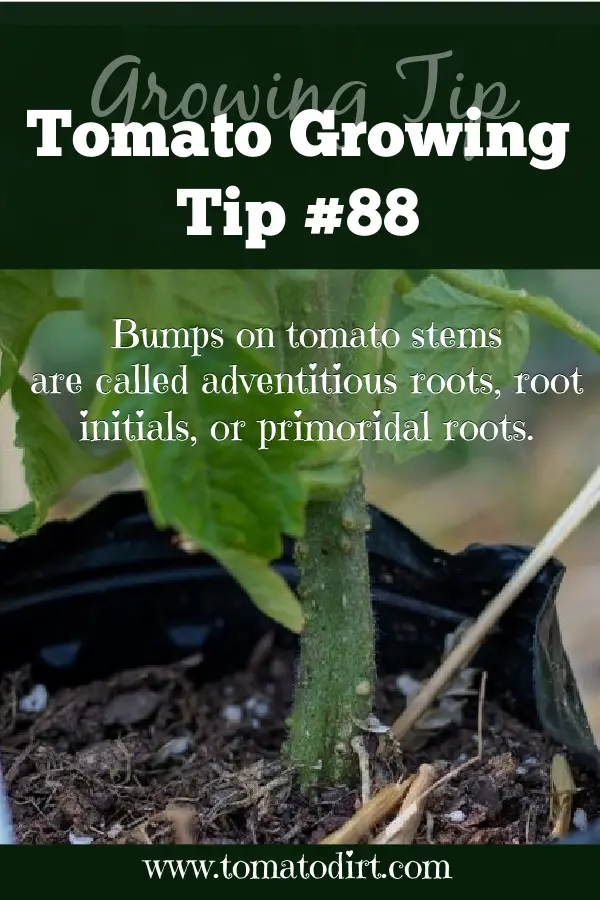Bumps on tomato stems – are they a serious problem?
Since 2010, Tomato Dirt has garnered 4.6+ million views, making it the web’s leading online source for growing tomatoes in the home garden. Award-winning writer and Tomato Dirt owner Kathy Widenhouse has helped thousands of home gardeners grow healthier tomatoes. Be one of them when you get Tomato Dirt’s Growing Guide here.
Updated 5.28.24
Bumps on tomato stems can be caused by various factors. But most of the time, bumpy tomato stems are not harmful to plants and are considered normal. True, there are a few instances where disease and pests are involved. We’ll give you the dirt on those other factors in a minute.
But first, let’s talk about the most common types of tomato stem bumps.
Adventitious roots: the most common type of white bumps on tomato stems
Bumps on tomato plant stems start as hundreds of tiny hairs up and down the stalk. Hairs can turn into roots when buried underground. Above ground, they form tiny nubs or nodules, also called root initials, adventitious roots, or tomato stem primordial. They are the earliest stage of development of a tomato’s roots.
When do bumps on tomato stems develop?

Root initials emerge on a tomato stem as a result of stress – most often when there’s a limit or blockage in the stem’s vascular flow. Specifically, a hormone named auxin in branch tips sends a signal to the plant’s roots when it’s blocked in the branch.
If there’s a blockage and the hormone can’t flow freely, it accumulates in the stem. Nodules or bumps emerge. The blockage can occur anywhere on the stem.
Blockages are caused by a number of things:
- internal injury
- irregular cell growth
- high humidity
- overly wet weather
- over-watering
- poor drainage
- in very occasional cases, disease (fusarium wilt or verticillium wilt, for example)
- other root damage
Often the blockage is water-related. A tomato plant’s roots need air as much as they need water. Over-watering or excess rain (including poor drainage) chokes them. The plant compensates by trying to develop more roots out through the stem – hence the root initials.
Root initials can be the same color as the stem. They may also be white or turn to brown.
When bumps on tomato stems grow excessively
If you see overgrown root initials on your plants, also check the leaves at the tops and the branch ends. Are they curled or stunted? That can indicate exposure to an herbicide.
Herbicide effects mimic the plant hormone auxin and can also cause abnormal stem growth and leaf distortion.
If your tomato patch is near your yard or a neighbor’s, perhaps a weed-and-feed product, weed control, or other herbicide was applied and drifted. Mist often affects tomato plants.
How do you control and treat bumps on tomato stems?
Root initials may not be attractive, but they do not harm plants.
- For root initials on lower stems: When root initials make contact the soil, they will grow. Mound compost around root initials on the lower part of the plant. They will develop into full-blown roots, strengthening the plant’s root system.
- For unstaked plants: If you have not yet staked plants and bumps appear on stems, you can continue to let the tomato vines sprawl on the ground instead of staking them. Root initials will grow into roots firmly attached to the soil.
- When wilt accompanies root initials: If you have a section of the garden with many root initials on plants that also have wilt problems, then the area is likely too wet there. If possible, alter watering habits.
How do you prevent bumps on tomato stems?
- Plant tomatoes in well-drained soil
- Don’t over-water
- Avoid applying herbicides in areas near the vegetable garden.
Bumps on tomato stems can indicate other problems
Occasionally, root initials can be a sign of other problems, so keep a close check on your plants. Look for signs of –
- wilting (can indicate fusarium wilt or verticillium wilt)
- browning leaves (can indicate root damage)
- stunted growth (can indicate root damage)
- top plant yellowing, black streaks on stem (can indicate pith necrosis)
If you find any of those factors, then bumps on tomato plant stems may be caused by one of these other tomato problems.
1. Edema
- Causes: Edema (oedema) occurs when plants take up water faster than it can be used. That makes cells to swell and form bumps. You’ll see edema most often when there’s high humidity and low light.
- Harmfulness: Edema is generally not harmful to the overall health of the plant, but it can indicate issues with water management.
- Prevention/Management: Improve air circulation around your tomato plants. That allows the air to move more readily in and out of stems, leaves, and fruit, which can slow the effects of humidity. Plus, when possible, water plants in the morning. That allows excess moisture in the soil and on the plant to evaporate throughout the day. Avoid overwatering and ensure proper drainage.
2. Galls
- Causes: Galls are abnormal outgrowths caused by various factors, including insects, bacteria, fungi, or nematodes. Common gall-forming pests include root-knot nematodes and certain bacteria like Agrobacterium tumefaciens, which causes crown gall disease.
- Harmfulness: Galls can be harmful as they disrupt the normal function of the plant's vascular system. Water and nutrients cannot flow easily to leaves (which make food for the plant), blossoms (which lead to fruit), and fruit (which need nutrients to ripen for picking). When your plant doesn’t have adequate nutrients, its growth gets stunted and it produces less fruit. Not what you want for a bumper tomato crop.
- Prevention/Management: Practice crop rotation to prevent soil-borne pests and pathogens. Use resistant varieties of tomatoes. If you suspect crown gall is the main culprit, then remove and destroy affected plants to prevent the spread of the bacteria.
3. Stem Canker
- Causes: Caused by fungal infections such as Fusarium or Phytophthora, stem cankers appear as dark, sunken lesions or bumps. They’re not the white spikes on the tomato stem that you associate with adventitious roots.
- Harmfulness: Cankers can be very harmful to your plant. Think wilt, poor growth – even death. Clearly stem cankers are not what you want for your crop.
- Prevention/Management: Avoid overhead watering to reduce moisture on leaves and stems. Apply fungicides if necessary and ensure good garden hygiene by removing and destroying infected plant material. Rotate crops and use resistant varieties.
4. Tomato Russet Mites
- Causes: While root initials cause white bumps on tomato stems, tomato russet mites look different. They’re microscopic pests, so you can’t see them. But you will see bronzing, russeting, and rough bumps on stems and even the plant’s leaves. Those bumps are the result of the russet mites having several good meals off of your tomato tissues.
- Harmfulness: Tomato russet mites can cause significant damage. They attack the green portions of your plant which reduces its ability to make food and sustain itself through photosynthesis. When a plant can’t use nutrients, sun, and water to make food, it naturally begins to starve. An unhealthy plant struggles to produce blossoms and fruit.
- Prevention/Management: Use miticides to control mite populations. Encourage beneficial insects like predatory mites. Keep the garden clean and remove plant debris that can harbor pests.
Prevent harmful bumps on tomato stems with these top tips
- Proper watering: Water plants consistently and avoid waterlogging. Water at the base of the plant to keep foliage dry.
- Air circulation: Space plants adequately to ensure good air circulation and reduce humidity around plants.
- Soil health: Maintain healthy soil with proper pH and nutrient levels. Use organic matter to improve soil structure.
- Hygiene: Practice good garden hygiene by removing diseased plant material and disinfecting tools.
- Resistant varieties: Choose disease-resistant tomato varieties to minimize the risk of infections.
- Monitoring: Regularly inspect plants for early signs of issues and address them promptly.
Got bumpy tomato stems? Check this first
Remember this … plenty of bumpy tomato stems are not harmful.
Once you’ve ensured that you’re following tomato plant care best practices, then check any emerging bumps for their color. White spikes on stems are likely adventitious roots.Do everything you can to help air flow freely around those root initials.
Who knows – in doing so you may even help your tomato plant develop a stronger root system.
More Tomato Problems
Other problems on tomato stems ...
Problems on tomato leaves ...
Problems on tomato fruit ...
Problems from tomato diseases
Different kinds of tomato blight and how to tell them apart ...
How to identify and treat early blight ...
How to identify and treat late blight ...
How to identify and treat Septoria leaf spot ...
Tomato pests
Tomato hornworm: how to identify and control it ...
Pests that attack tomatoes in containers ...
Stink bugs: how to identify and control them on tomato plants...
Tomato worms - cutworms: how to keep them away ...
Problems from growing conditions
Blossom end rot: how to identify, treat, and prevent it ...
15 ways to prevent blossom end rot in tomatoes ...
Why a tomato cracks and what to do about it ...
Tomato sunscald: why too much sun is hazardous to tomatoes...
Help Your Tomatoes Set Fruit with These Tips ...
Tomato Problems: how to identify and prevent them...
Return from Bumps on Tomato Stems to Tomato Dirt home
As an Amazon Associate and Rakuten Advertising affiliate I earn from qualifying purchases.
SHARE THIS PAGE:
FREE! 10 Must-Know Tomato Growing Tips: 20-page guide
Get yours here:






New! Comments
Have your say about what you just read! Leave a comment in the box below.